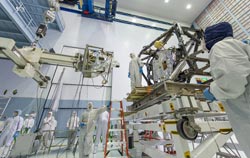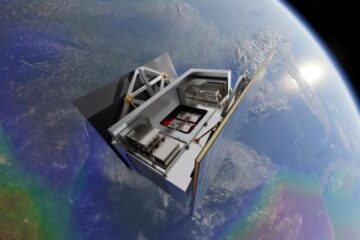NASA Completes First Part of Webb Telescope's ‘Eye Surgery’ Operation

<br>
It's high-stakes surgery that has taken years of preparation. This science instrument must fit precisely into the ISIM, or Integrated Science Instrument Module (the black frame on the right to which they install the MIRI), so that it is installed exactly where it needs to be within the width of a thin human hair.
This intricate process involves a tremendous amount of work from the engineering team to make sure the instrument is settled and installed just right. The MIRI itself weighs 181 pounds (82 kg) and is being held by a crane (on the left of the photo), which is being maneuvered by the engineer at the base of the ladder. Each engineer has a role in the process that must be done as delicately as possible so as not to disturb anything, said Jason Hylan, the engineer responsible for the operation from start to finish.
Disturbing MIRI would cost the mission the critical science that will help shape our knowledge of the universe, and push the boundaries of scientific discoveries. For that reason, precise engineering is key and that can put some of the engineers in awkward positions, literally.
“Because we are trying to put so much stuff into such a small space, we always run into problems related to access,” Hylan said. “This is somewhat akin to working on a car under the hood – some things are easy to get to because they are on the outside of where you are working. Other parts are buried and are very difficult to get to. Much of what we have to integrate is on the 'inside' and so access is very difficult. During the operation, we need to access multiple things at the same time and one person may only be able to access one area, so we need multiple people all around doing the same thing at the same time. It is a very coordinated operation.”
Hylan said that, like watching the new World Trade Center being built in New York right now, the process is tedious, but the end result is something significant that will leave its mark on a generation.
The James Webb Space Telescope is the successor to NASA's Hubble Space Telescope. It will be the most powerful space telescope ever built and observe the most distant objects in the universe, provide images of the first galaxies formed and see unexplored planets around distant stars. The Webb telescope is a joint project of NASA, the European Space Agency and the Canadian Space Agency.
Laura Betz
NASA's Goddard Space Flight Center, Greenbelt, Md.
Media Contact
All latest news from the category: Physics and Astronomy
This area deals with the fundamental laws and building blocks of nature and how they interact, the properties and the behavior of matter, and research into space and time and their structures.
innovations-report provides in-depth reports and articles on subjects such as astrophysics, laser technologies, nuclear, quantum, particle and solid-state physics, nanotechnologies, planetary research and findings (Mars, Venus) and developments related to the Hubble Telescope.
Newest articles

Microscopic basis of a new form of quantum magnetism
Not all magnets are the same. When we think of magnetism, we often think of magnets that stick to a refrigerator’s door. For these types of magnets, the electronic interactions…

An epigenome editing toolkit to dissect the mechanisms of gene regulation
A study from the Hackett group at EMBL Rome led to the development of a powerful epigenetic editing technology, which unlocks the ability to precisely program chromatin modifications. Understanding how…

NASA selects UF mission to better track the Earth’s water and ice
NASA has selected a team of University of Florida aerospace engineers to pursue a groundbreaking $12 million mission aimed at improving the way we track changes in Earth’s structures, such…





















